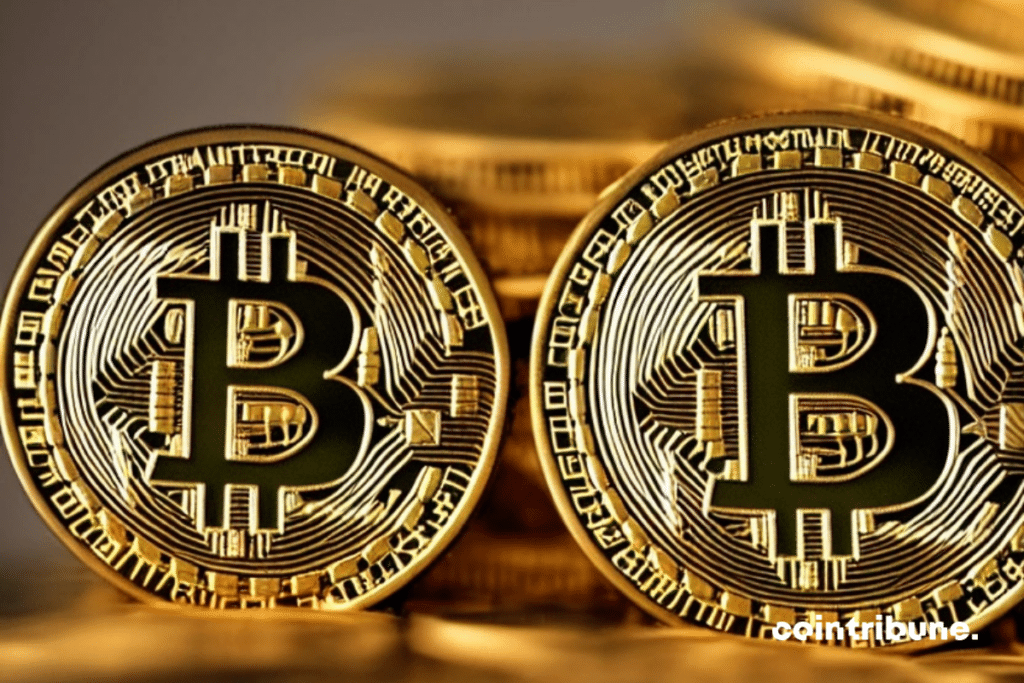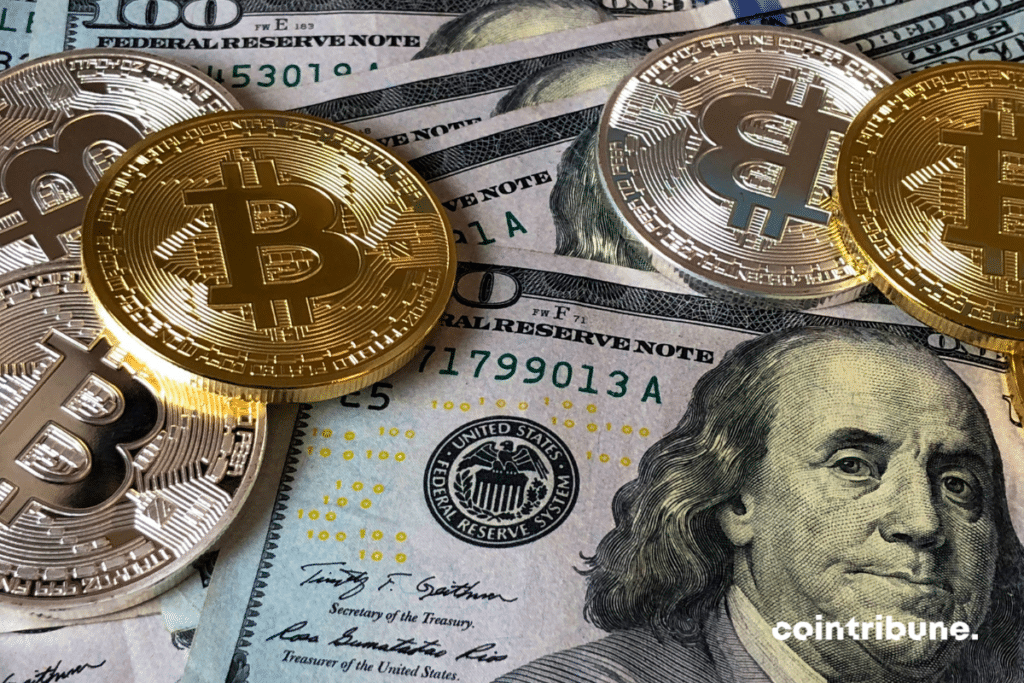History of Bitcoin: From genesis to the present day
Bitcoin was born in one of the most tumultuous financial contexts the United States, and indeed the world, has ever seen. From 2007 to 2009, the subprime crisis cultivated a distrust of governments and banks among the population, leading to a questioning of the entire monetary system. Amidst this turmoil, a mysterious man appeared with an idea that would revolutionize the very foundations of currency. Discover the most significant facts in the history of Bitcoin (BTC) in this feature!

The Mysterious Satoshi Nakamoto
On October 31, 2008, a certain Satoshi Nakamoto sent the following message to a cryptography mailing list: “I’ve been working on a new electronic cash system that’s fully peer-to-peer, with no trusted third party.” Following these words, he introduced a white paper titled: “Bitcoin: A Peer-to-Peer Electronic Cash System.”
In this 9-page document, Satoshi laid out the idea of a decentralized digital payment system immune to double-spending and capable of conducting transactions anonymously. For further details, he directed readers to a website named Bitcoin.org, which would contain the full white paper of the project. In reality, two months earlier, this domain name was registered by an unidentified person, presumably Satoshi himself.
It is important to note that, according to him, he had begun working on the design and development of this project in 2007. Many digital currency projects from that time, such as Nick Szabo’s Bit Gold, reportedly inspired him.
The Beginnings of Bitcoin
After its publication, the Bitcoin white paper piqued the interest of certain specialists who then offered to help Satoshi. Finally, on January 3, 2009, the first block of the network was mined.
On January 8, Satoshi announced the release of the first client version of the platform, Bitcoin v0.1 Release. This marked the beginning of Bitcoin mining as it allowed early adopters to participate in the protocol’s operations.
At the time, the software was only compatible with the Windows operating system. It wasn’t until December 17, 2009, with version 0.2.0, that compatibility with Linux was established.
The First Block
On January 3, 2009, Satoshi Nakamoto mined the first block of the Bitcoin blockchain. Named the Genesis Block, it came with a reward of 50 BTC. However, unlike the rewards from subsequent blocks, the bitcoins from this block could not be transferred. It is unclear whether this was due to a programming error or a deliberate decision by Satoshi.
Inside the Genesis Block, block 0, was the following quote: “The Times 03/Jan/2009 Chancellor on brink of second bailout for banks.” This was a reference to an article published in The Times of London that day. Many saw this message as a sign that Bitcoin was a response to the 2008 financial crisis.
The mining of the first Bitcoin block marked the beginning of the blockchain and paved the way for a new industry.

The First Transaction
The first transaction occurred on January 12, 2009, between Satoshi Nakamoto and cryptographer Hal Finney. Conducted during block 170, it involved a sum of 10 BTC. Finney hoped that Bitcoin would become a global reference currency.
However, it wasn’t until the very beginning of October 2009 that Bitcoin received its first official value estimation, determined based on its production cost. At that time, one BTC was worth approximately $0.001.
Furthermore, on October 12, 2009, the New Liberty Standard, one of the first cryptocurrency exchanges, facilitated the first exchange of BTC for dollars. A BitcoinTalk forum user had purchased 5,050 bitcoins for $5.02 via PayPal, equating to $0.00099 per unit.
First Retail Purchase with BTC
Gradually, Bitcoin made its way to the mainstream, gaining some followers along the way. However, although the number of BTC holders had increased, it was still difficult to exchange them on trading platforms.
The year 2010 was memorable for Bitcoin, as it witnessed many significant events. Among them was the infamous story of Laszlo Hanyecz, the very first BTC miner to experiment with GPU mining. At that time, bitcoins were very easy to mine, and Laszlo held a large number. On the BitcoinTalk forum, he offered to trade 10,000 BTC for 2 pizzas. Thus, on May 22, 2010, the first retail transaction involving bitcoins took place. To commemorate this historic act, the crypto community instituted “Bitcoin Pizza Day,” which is celebrated each year on May 22.
It was also in 2010 that Satoshi Nakamoto chose to withdraw from the project and appoint Gavin Andresen as his successor.
First BTC Hack
Two months later, on August 15, 2010, developer Jeff Garzik alerted BitcoinTalk forum members to the oddity of a particular block. Upon analysis, they realized that a malicious individual had exploited a vulnerability in the Bitcoin source code to generate 184 billion BTC, which they had transferred to two different addresses. Four hours later, project contributors and miners managed to contain the flaw by performing the first major protocol update. Since then, the network has not shown any notable security failures.
Parity with the USD
On February 9, 2011, Bitcoin reached parity with the dollar. In other words, for the first time, one BTC could be exchanged for one dollar. This positive dynamic continued until June, when the price of BTC nearly reached $32.
At the same time, other blockchain projects were launched. The first among them was Namecoin. Launched on April 18, 2011, it is a platform based on the Bitcoin source code, whose business was the registration of decentralized domain names.

First Competitors to BTC
Interestingly, Satoshi largely contributed to the emergence of this project. In December 2010, in a discussion thread titled BitDNS and Generalizing Bitcoin, he provided an interesting solution on how to generate domain names in a decentralized environment, previously perceived as impossible.
WikiLeaks Adopts Bitcoin
Toward the end of 2010, the renowned organization WikiLeaks considered turning to BTC to raise funds. At the time, because it had published sensitive government information, it had been banned by major financial service providers such as VISA, MasterCard, and PayPal.
Its willingness to adopt Bitcoin generated a lot of excitement within the crypto community. However, Satoshi was not very enthusiastic about this news. He indeed felt that the project was not mature enough to support such deployment. Moreover, he feared that government pressures induced by this initiative would lead to the premature end of the nascent protocol. That’s why he asked WikiLeaks not to go through with his idea in this threatening context.
The association eventually agreed and chose to postpone the launch of its Bitcoin donation mechanism to a later date, when the currency would have consolidated its position. Finally, it was only on June 14, 2011, after the first surge in the price of the queen of cryptocurrencies, that the WikiLeaks address was launched.
First Crypto Exchange
In the early days of Bitcoin, it was not very accessible to the general public. To acquire it, one essentially had to be a miner. That’s why it became crucial to create marketplaces where people could more easily obtain BTC.
The first exchange to emerge was the Bitcoin Market. Launched in March 2010, this platform allowed Bitcoin enthusiasts to trade crypto-assets for dollars. Initially, the site accepted payments via PayPal.
But in June 2011, the exchange finally withdrew its support for PayPal due to the increasing number of fraudulent transactions. Moreover, even though Bitcoin Market was doing well initially, the platform was quickly ousted by its competitors because it could not handle the ever-growing number of Bitcoiners.
First BTC Theft
Meanwhile, on June 13, 2011, a Bitcointalk forum user declared that they had been robbed of 25,000 BTC. In reality, a hacker had corrupted their computer and broken into their Slush Pool account (the very first mining pool) to steal a portion of their mining rewards. At that time, it was difficult to trace the stolen coins, as the only online block explorer functioned intermittently.
However, the stolen funds were traced to an exchange platform where they had been transferred to be converted into dollars. At the time, the loot was estimated at $5 million.
Silk Road or How Bitcoin Became the Currency of the Dark Web
Silk Road is a marketplace that was launched in February 2011 to facilitate transactions on the Darknet. It is primarily to it that Bitcoin owes its reputation as the criminals’ currency. It allowed the use of BTC for purchasing drugs and other unauthorized substances. Its users exploited it anonymously using the TOR browser. The site quickly gained popularity, reaching a million transactions per day. Just a few months after its launch, Silk Road became the subject of an investigation by the DEA, a federal agency specialized in combating drug trafficking.
Eventually, in October 2013, the FBI shut down the site, and its creator, Ross Ulbricht, was arrested and convicted on seven charges related to Silk Road. Subsequently, the United States proceeded with an auction of approximately 29,000 BTC seized in this case.
Bitcoin History: Mt. Gox, the Biggest Hack
Mt. Gox has left an indelible mark on the annals of BTC, but not necessarily in a good way.
In 2007, Jed McCaleb registered the domain name mtgox.com. He intended to use it to launch a project for trading collectible cards: “Magic: The Gathering Online eXchange (Mt Gox).” He quickly realized that this business was not profitable. However, he decided to keep the domain name.
In 2010, he discovered Bitcoin and decided to set up his own BTC exchange using mtgox.com as the domain name. This project, which started rather timidly, suddenly took off in 2013. At that time, Mt. Gox was the leader in Bitcoin exchanges, accounting for more than 70% of the global market share. However, behind the scenes, heavy secrets were hidden.
Indeed, from 2011 to 2014, the platform reportedly suffered a series of hacks that resulted in the theft of 844,408 bitcoins. The publication of this news shook the ecosystem, especially the millions of Mt. Gox users who lost their assets in this affair, which according to some sources, was the consequence of poor management. This story almost led to the collapse of Satoshi Nakamoto’s currency.
In the process, Mark Karpelès, who had bought an 88% stake in the exchange in 2011 and had become its CEO, was accused of fraud and embezzlement. In addition, the U.S. government seized $5 million because the exchange was offering money transfer services in the United States without a license. Eventually, it went bankrupt, and Karpelès was sentenced on March 15, 2019, to 2.5 years in prison with a four-year probation for data falsification.
Games Adopt Bitcoin
In January 2014, Zynga, a social gaming company, announced that it would now accept Bitcoin as a payment method. This was thanks to a partnership with BitPay, a cryptocurrency payment platform.
Following this announcement, the price of the pioneer cryptocurrency jumped beyond the $1,000 mark. On Reddit, the company explained that this decision was part of a proactive approach to respond to the growing popularity of BTC. Thus, a proof of concept was launched on seven of the brand’s games.
That same month, the online casino Vera & John became the first regulated establishment to accept Bitcoin deposits. Moreover, toward the end of that year, Microsoft also allowed Bitcoin payments for purchasing Xbox games and Windows software.
The Bitcoin Windfall
In 2017, individual interest in BTC reached a peak. What’s more, more and more companies accepted it as a payment method. All this naturally led to a significant increase in transaction volume.
In November of that year, the price of Bitcoin surpassed $10,000 for the first time, having just reached $1,000 in January. The market had not yet said its last word, and in December 2017, Bitcoin reached a price of $19,783 per unit.
ICO Boom
At that time, this bullish dynamic was observed across the entire cryptocurrency market. It was influenced by the massive influx of investors into the sector, itself driven by the phenomenon called “the ICO boom.” Initial Coin Offerings (ICOs) represent the most popular project funding mechanism in the industry. In exchange for their contribution, investors received specific tokens for the project on which they could then speculate. This process allowed crypto startups to raise more than $17.8 billion in funds between January 2017 and July 2018. The hitch is that many of these projects were either scams or poorly formalized initiatives. Thus, toward the end of 2018, this speculative bubble burst, and the market plummeted.
First Hard Fork
Still in 2017, the first project resulting from a fork of the main Bitcoin network chain came into being. Named Bitcoin Cash, it was launched on August 1 following a disagreement among community members over issues related to scalability. After this bifurcation, the original Bitcoin chain, called Bitcoin Core, continued its usual operation.
Bitcoin Becomes a Legal Currency
In June 2021, the Congress of El Salvador passed a bill to make Bitcoin the country’s second official national currency. This law came into effect on September 7 of the same year. El Salvador thus became the first country in the world to give legal tender to BTC.
Subsequently, on April 21, 2022, the Parliament of the Central African Republic (CAR) also recognized Bitcoin as legal currency. The country entered history as the first in Africa and the second in the world to legalize BTC.
These key moments in the history of Bitcoin show us that, time and again over the years, the queen of cryptocurrencies has almost met her demise. But the ideological foundations underlying it have guaranteed its unparalleled success. Although it has already accomplished great feats in its few years of existence, BTC still has much to offer, and its ascent is just beginning.
Maximize your Cointribune experience with our "Read to Earn" program! For every article you read, earn points and access exclusive rewards. Sign up now and start earning benefits.
The Cointribune editorial team unites its voices to address topics related to cryptocurrencies, investment, the metaverse, and NFTs, while striving to answer your questions as best as possible.
The views, thoughts, and opinions expressed in this article belong solely to the author, and should not be taken as investment advice. Do your own research before taking any investment decisions.